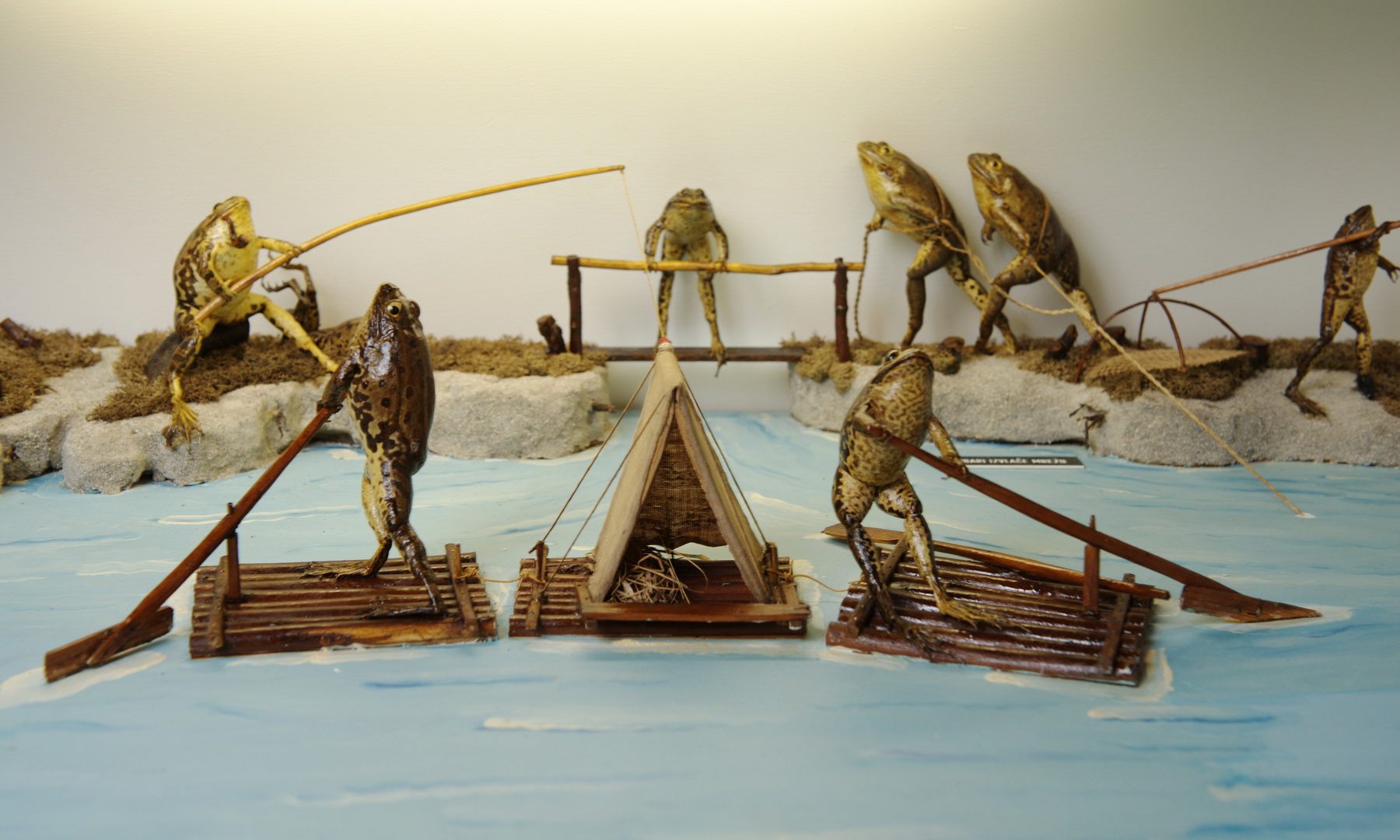The Hungarian Taxidermist Who Saw Frogs As People
Ferenc Mere’s passion lives on as Froggyland, a museum full of anthropomorphic amphibians.

A Froggyland camping tableau. (All photos courtesy Froggyland)
Many children catch frogs, and many also spend time in imaginary, whimsical worlds. But it’s a rare human who melds these two hobbies into an artistic calling.
Ferenc Mere, a Hungarian taxidermist, spent a decade of his life stuffing hundreds of dead frogs, and casting them in meticulous dioramas. Seventy years after his own death, his legacy lives on as Froggyland, the last bastion of the lost art of amphibian taxidermy.
As much as we might like to know more about Froggyland’s amphibian-stuffing curator, his life is largely shrouded in mystery. According to the current proprietors of Froggyland, Mere was born in 1878 to Hungarian parents. He spent his childhood in the former Yugoslavia, near “a big pond full of frogs.” He grew to love his ribbiting neighbors very much, and would fall asleep to the sound of their croaks, dreaming about their full, froggy lives.

A Mere creation works on his sewing.
Meanwhile, elsewhere in Europe, taxidermy was all the rage. The late 19th century saw natural historians and museum curators improving animal preservation technology by leaps and bounds. Artistic innovators like Hermann Ploucquet and Walter Potter married technical chops with anthropomorphic artistry, dressing up mice and rabbits in human clothes and putting them in relatable situations—tea parties, classrooms, cricket fields. These tableaus were particularly popular with British audiences, beguiling everyone from Charles Darwin to Queen Victoria.
Mere, too, was inspired by this work, and decided to use it to bring his childhood dreams to life. Good amphibian taxidermy was considered particularly top-notch, as it is difficult to properly stuff a frog without damaging his or her fragile skin. Even today, many professionals don’t bother with frogs. ”Their skin can shrink and look not quite right,” says Amber Maykut, a taxidermy artist at HoardaCulture. Popular taxidermy supply catalogs don’t offer frog-facing tools, even as they’re rife with gadgets to help stuff snakes and fish.
Faced with a dearth of methodology, Mere developed his own special technique, which allowed him to keep his frogs lifelike long after death. Though the particulars remain secret, we do know that he stuffed them with cork and sawdust through their mouths, avoiding distracting seams, and replaced their eyes with glass, complete with tiny realistic eyelids. From 1910 to 1920, Mere prepared over a thousand frogs in this way.

Froggyland frogs modeling various outdoor activities.
Half of these have since been lost to time. The rescued 500 make up Froggyland, a whimsical menagerie that doubles as Mere’s legacy. Within Froggyland’s 21 displays, frogs play out scenes from full human lives. Pollywog schoolchildren pass rulers back, answer difficult math problems, and cheat off each others’ homework. Four play doubles tennis, while others wait on the bench smoking pin-sized cigarettes. At an all-amphibian circus, frogs hang upside-down, form athletic pyramids, and participate in impressive feats of strength.
As realistic as they are, Mere’s results bring to mind other constraints inherent to frog taxidermy. For one thing, frogs essentially lack necks. With rare exceptions, Mere’s 500 subjects look perpetually upward, regardless of what they’re meant to be doing. The tennis spectators seem aloof or distracted. A frog dentist, prying out a patient’s tooth, seems to be trying to keep his head as far away from said patient’s mouth as possible.

The extremely impressive Froggyland Circus.
Froggyland is a time capsule in more ways than one. “No one I know works with amphibians,” says Leah Polans, a taxidermist at The Evolution Store in Soho, New York. Today, Polans points out, many people take to taxidermy as a way to preserve hunting trophies—thus the prevalence of wall-mounted deer heads and rearing bears. Since people don’t generally stake out frogs, they’re less likely to end up dramatically stuffed. Those who want to keep one or two around are more apt to jar them as “wet specimens,” floating them for eternity in alcohol or a glycerine solution.
In the years since Ploucquet and Potter, anthropomorphism, too, has lost a bit of its cultural clout. Though there are some modern practitioners, like Maykut, many who put their specimens in deliberately contrived situations are more likely to frame their work as fine art, or as a joke, says Polans. Mere’s work, with its mix of whimsy and seriousness, seems too amphibious to fit in either camp.
But the thrill of taxidermy is in its boundary-crossing, and though Polans herself tends to veer towards realism in her own work, she admires Mere’s creativity. “It’s like a little world you want to exist within,” she says. “You want to be hanging out with the frogs.”
If you want to experience Mere’s work for yourself, join us on April 16 for Obscura Day at Froggyland—or try out some artistic preservation yourself at The Evolution Store’s insect-pinning class, part of the New York Secret Garden Party.
Naturecultures is a weekly column that explores the changing relationships between humanity and wilder things. Have something you want covered (or uncovered)? Send tips to cara@atlasobscura.com.









Follow us on Twitter to get the latest on the world's hidden wonders.
Like us on Facebook to get the latest on the world's hidden wonders.
Follow us on Twitter Like us on Facebook